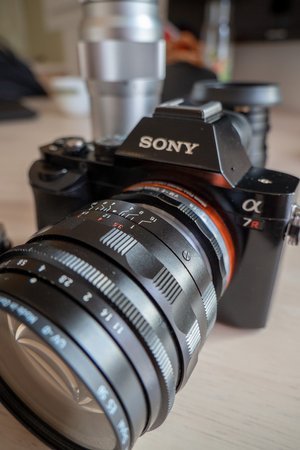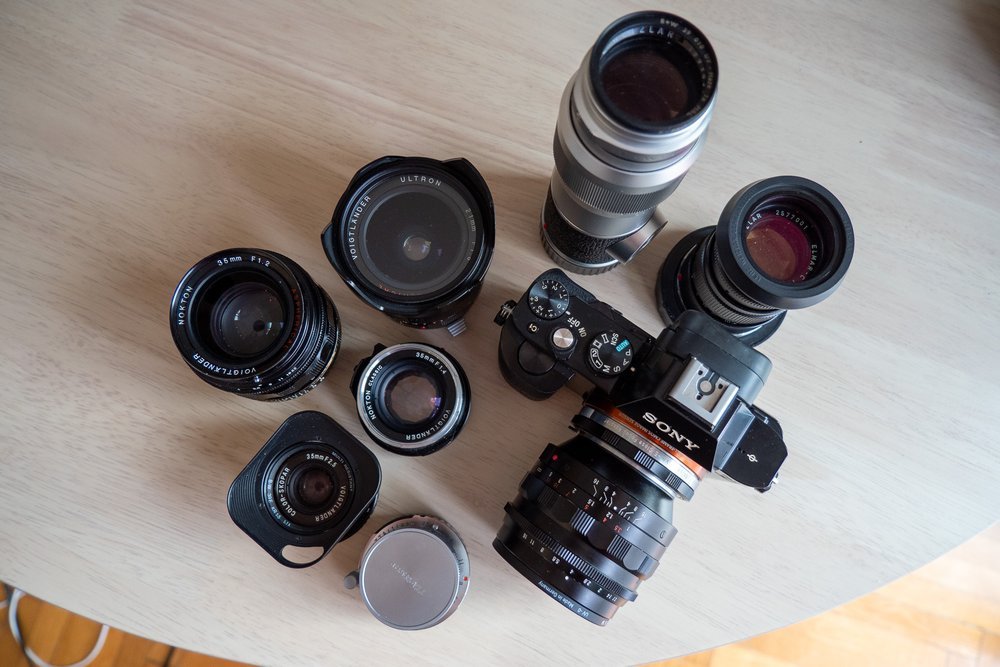5 Reasons I Shoot M-Mount Lenses But Not Leica
Over the last few months I’ve added 8-10 new lenses to my collection, but they aren’t native to my Olympus e-m1 ii or my Sony a7r. All my most recent purchases have been Leica M-mount lenses.
I know it isn’t unusual for people to begin investing in M-mount glass in preparation for buying their Leica dream camera in the future, but in my case, I have no intention (or interest) in buying a Leica M rangefinder. I don’t think a Leica would be a good match for my personal shooting style, and I can think of a lot of other cameras I’d rather have for the money.
So why invest in Leica M-mount glass if a digital M isn’t on the horizon? In this article I’ll give you 5 reasons why M-mount still appeals to me.
Voigtlander 50mm f1.1 on a Sony a7r
Leica Elmar 135mm f4
Reason #1 - I’m Non-committal
I am not a brand loyalist… although my Ricoh GR III threatened to turn me into one. Personally speaking, one of the real joys of photography is having the opportunity to try out all the unique camera offerings from each manufacturer. I love shooting micro 4/3 bodies, aps-c bodies, full-frame bodies, and all the quirky options in between.
That said, I’m not a rich man with thousands of dollars in disposable income, and purchasing good lenses for every camera mount gets really expensive really fast.
One of the reasons M-mount lenses appeal to me is because they can be adapted to almost any mirrorless camera body in existence. I regularly swap my Voigtlander and Leica lenses between my Olympus e-m1 mark ii and my Sony a7r. In the near future, I’m hoping to purchase a Fujifilm aps-c camera and the full-frame Sigma fp, but rather than purchasing a separate collection of X-mount and L-mount lenses, I’m going to adapt the M-mount glass I already own.
I love the fact that I can buy M-mount lenses once and then use them on all kinds of cameras.
TTArtisan 28mm f5.6 adapted to a Sony a7r
Voigtlander 35mm f1.2 version 1
Reason #2 - I Enjoy Manual Focus More than I Expected
The most polarizing feature of M-mount lenses is that they are manual focus only. The photography purists and cinematographers love it, while the rest of the camera world is happy to leave it behind in the annuls of history.
When I first started photographing I was part of the latter group. My first purchase was, of course, a Sony because, of course, their auto focus is second-to-none. I had no interest in the “slow, inaccurate, and tedious” world of manual focus. That was, until I tried a manual focus lens for the first time, the 7Artisans 35mm f0.95 which I reviewed on this website. That lens opened my eyes to the craft of photography as a process, rather than a rush to the end result.
I’m not going to try to convince you that manual focus is great for everyone, but I will encourage you to try it, especially if, like me, you wrote it off without giving it a chance. You may find you enjoy it more than you expect.
TTArtisan 28mm f5.6
Reason #3: Price
This one might shock some people because M-mount lenses are notorious for being expensive, with some Leica lenses exceeding $10,000. But if you aren’t stuck on the Leica brand name, and you are willing to be patient, you can find a lot of great M-mount glass at reasonable prices.
I know this to be true because I’ve successfully built a nice collection of M-mount lenses for less money than most people would assume. Below I’ve listed my current M-mount lenses and the prices I paid for them. All lenses were purchased in excellent used condition with no fungus, haze, or scratches:
Voigtlander 21mm f1.8 - $360
TTArtisan 28mm f5.6 - $150
Voigtlander 35mm f2.5 - $195
Voigtlander 35mm f1.4 - $200
Voigtlander 35mm f1.2 v1 - $325
TTArtisan 50mm f1.4 - $125
Voigtlander 50mm f1.1 - $350
Leica Elmar C 90mm f4 - $175
Leica Elmar 135mm f4 - $102
I’m pretty happy with my purchases, especially considering the quality of the glass. In my opinion, the best way to shop for M-mount lenses is patiently. I know it’s difficult to wait for a good deal when you have GAS, but patience will save you hundreds of dollars when the right deal appears. I buy exclusively on Ebay and I regularly find excellent gear at excellent prices.
M-mount lenses from Leica, Voigtlander, and TTArtisan
Reason #4 - Build Quality and Longevity
This one won’t be a surprise to anyone who has ever used an M-mount lens. M-mount lenses are built different, in a good way.
In my old age (32 years on the earth), I’ve grown nostalgic for the build quality of yesteryear. I’m tired of the plastic fantastic, replace after one year, Chinese built products of the 2000s. The more cheap products I’ve thrown away, the more I’ve warmed up to the idea of buying a quality product once and having it last a lifetime. Sure, modern nifty-fifties are great value for money, but I’d rather pay double (or triple) for a lens that will last me a lifetime.
Last year my wife and I moved internationally and whittled our possessions down to what would fit in 4 suitcases. That process taught me the value of having a few quality possessions, rather than a house full of cheap goods. I want to invest in my lenses with the confidence they’ll still be with me a decade from now.
I don’t need new friends every week, I just want a few old familiar friends.
While the lack of electrical components and auto-focus in M-mount lenses is considered a disadvantage by some, in the longevity department, it’s a real advantage. Technology is changing rapidly and lenses that utilize a lot of electronics date themselves much quicker than manual lenses. Companies engineer new auto-focus motors, lens mounts change, lenses aren’t always compatible with adapters, etc.. But even after 60 years, my Leica Elmar 135mm f4 is still just as functional as it was in the 1960s (no firmware updates required). I’m looking forward to using my M-mount lenses on camera bodies in the 2030s without stressing about them becoming outdated or incompatible.
Voigtlander 21mm f1.8 Ultron
Reason #5 - One Lens, Multiple Focal Lengths
As I mentioned above, I enjoy shooting my M-lenses on multiple camera bodies. Consider my Sony a7r (full-frame) and my Olympus e-m1 mark ii (micro four thirds) for a moment. If I use my Voigtlander 50mm f1.1 on my a7r, it gives me a 50mm focal length. But if I use the same lens on my Olympus I have a 100mm focal length (because of the 2x crop factor on m4/3). If I were to purchase an aps-c camera body, I would have a 75mm field of view from the same lens.
This means I can buy one lens and use it in a variety of creative ways. It helps keep my photography fresh and exciting. I know this reason may only interest a niche audience, but it’s worth pointing out.
I should also mention, M-mount lenses are the ideal optic for adapting across different brands because their small size makes them feel at home on any camera body.
Olympus e-m1 mark ii with adapted Lecia Elmar 135 f4 (270mm equivalent)
100% crop
Leica Elmar 135mm f4… I believe this lens was made in 1959
Conclusion:
While I don’t have any intention of buying a Leica M-mount camera, I’m a big fan of the lenses that have grown up around the system. They certainly aren’t going to fill everyone’s needs, but for a few of us, they are the perfect fit.
I’m planning to invest some more money in the M-mount system. I’m waiting for a good deal on the legendary Voigtlander 50mm f2 apo-lanthar and I would really like to get my hands on a good 28mm lens.
If you’ve never tried adapting an M-mount lens to your mirrorless body before, give it a try! You can always rent a lens or buy one used and resell it if you hate it (luckily M-mount lenses hold their value well - Reason #6 lol).
Who knows, you might turn out like me… going from someone who swore they would never use manual focus, to owning so many M-lenses I regularly get called into airport security for having multiple metal and glass cylinders in my checked bag.
Sony a7r with adapted Voigtlander 35mm f1.4 version 1











